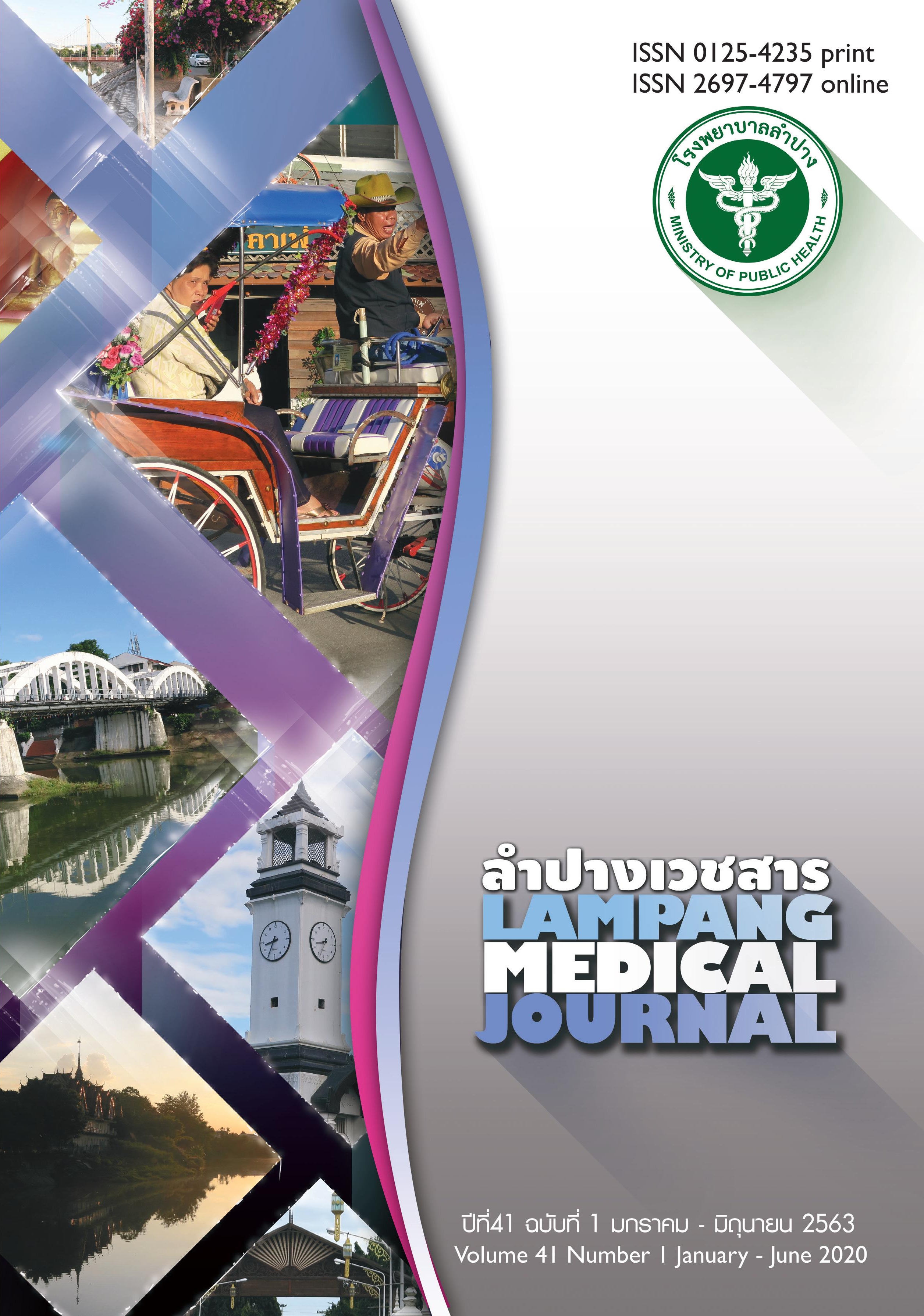ความชุกและความสัมพันธ์ทางพยาธิวิทยาคลินิกของต่อมไทรอยด์อักเสบเรื้อรังฮาชิโมโต ในมะเร็งต่อมไทรอยด์ชนิดแปปปิลลารีภายหลังการรักษาด้วยสารรังสีไอโอดีน-131
Main Article Content
บทคัดย่อ
ภูมิหลัง: ผู้ป่วยมะเร็งต่อมไทรอยด์ชนิดแปปปิลลารี (papillary thyroid cancer, PTC) บางรายมีลักษณะร่วมของต่อมไทรอยด์อักเสบเรื้อรังฮาชิโมโตหรือ chronic lymphocytic thyroiditis (CLT) ยังไม่มีข้อมูลที่ชัดเจนของความสัมพันธ์ระหว่าง CLT กับปัจจัยทางพยาธิวิทยาคลินิกและการตอบสนองต่อการรักษาด้วยสารรังสีไอโอดีน-131
วัตถุประสงค์: เพื่อศึกษาความชุกของ CLT ในมะเร็ง PTC และศึกษาความสัมพันธ์กับปัจจัยทางคลินิกและพยาธิวิทยา ภายหลังการรักษาด้วยสารรังสีไอโอดีน-131
วัสดุและวิธีการ: เป็นการวิจัยเชิงวิเคราะห์แบบตัดขวาง ในผู้ป่วยมะเร็ง PTC ที่ได้รับการผ่าตัดในรพ.สุราษฎร์ธานี ในช่วง ม.ค. 2552 - พ.ค.2559 บันทึกข้อมูลทางคลินิกลักษณะทางพยาธิวิทยาและการตอบสนองภายหลังการรักษาด้วยสารรังสีไอโอดีน
เปรียบเทียบทางสถิติระหว่างกลุ่มที่มีและไม่มีลักษณะของ CLT วิเคราะห์หาปัจจัยที่สัมพันธ์กับการมี CLT ด้วย logistic regression analysis
ผลการศึกษา: ผู้ป่วยมะเร็ง PTC 277 ราย ส่วนใหญ่เป็นเพศหญิง 250 ราย (ร้อยละ 90.2 ) อายุเฉลี่ย 42.9±13.0 ปี (พิสัย 19-84 ปี) พบว่ามี CLT 65 ราย (ร้อยละ 23.5) กลุ่มที่มี CLT ตอบสนองต่อการรักษาด้วยรังสีไอโอดีน-131 แบบดีเยี่ยม
สูงกว่ากลุ่มที่ไม่มี CLT (ร้อยละ 80.0 vs 66.5, p=0.038) และการตอบสนองต่อรังสีไอโอดีนแบบดีเยี่ยม มีความสัมพันธ์กับภาวะ CLT เมื่อวิเคราะห์ถดถอยแบบตัวแปรเดียว (OR 2.01, 95%CI 1.03-3.94, p=0.041) เมื่อวิเคราะห์แบบพหุตัวแปรพบว่า ปัจจัยที่สัมพันธ์กันคือ เพศหญิง (adjusted OR 10.59, 95%CI 1.31-85.65, p=0.027) ขนาดของก้อนมะเร็งไม่เกิน 1 ซม. (adjusted OR 1.86, 95%CI 1.06-1.93, p=0.041) ลักษณะทางพยาธิวิทยาที่มี extrathyroidal extension (adjusted OR 0.25, 95%CI 0.08-0.77, p=0.016) และ capsular invasion (adjusted OR 0.29, 95%CI 0.09-0.96, p=0.042)
สรุป: ต่อมไทรอยด์อักเสบเรื้อรังฮาชิโมโตในมะเร็ง PTC พบความชุกของร้อยละ 23.5 มีความสัมพันธ์กับเพศหญิงและขนาดของก้อนมะเร็งไม่เกิน 1 ซม. นอกจากนี้ยังมีแนวโน้มที่จะตอบสนองในระดับดีเยี่ยมต่อการรักษาด้วยรังสีไอโอดีน-131
Article Details
บทความที่ส่งมาลงพิมพ์ต้องไม่เคยพิมพ์หรือกำลังได้รับการพิจารณาตีพิมพ์ในวารสารอื่น เนื้อหาในบทความต้องเป็นผลงานของผู้นิพนธ์เอง ไม่ได้ลอกเลียนหรือตัดทอนจากบทความอื่น โดยไม่ได้รับอนุญาตหรือไม่ได้อ้างอิงอย่างเหมาะสม การแก้ไขหรือให้ข้อมูลเพิ่มเติมแก่กองบรรณาธิการ จะต้องเสร็จสิ้นเป็นที่เรียบร้อยก่อนจะได้รับพิจารณาตีพิมพ์ และบทความที่ตีพิมพ์แล้วเป็นสมบัติ ของลำปางเวชสาร
References
Jung CK, Little MP, Lubin JH, Brenner AV, Wells Jr SA, Sigurdson AJ, et al. The increase in thyroid cancer
incidence during the last four decades is accompanied by a high frequency of BRAF mutations and a sharp increase in RAS mutations. J Clin Endocrinol Metab. 2014;99(2):E276-85.
Sriplung H. Thyroid. In: Imsamran W, Chaiwerawattana A, Wiangnon S, Pongnikorn D, Suwanrungrung K, Sangrajrang S, et al., Cancer in Thailand: Vol VIII, 2010-2012. Bangkok: National Cancer Instritute, Thailand; 2015. p. 64-6.
Greenspan BS. Radioiodine treatment of welldifferentiated thyroid cancer: balancing risks and benefits. J Clin Oncol. 2018;36(18):1785-7.
Cooper DS, Doherty GM, Haugen BR, Kloos RT, Lee SL, Mandel SJ, et al. Revised American Thyroid
Association management guidelines for patients with thyroid nodules and differentiated thyroid cancer: American Thyroid Association (ATA) Guidelines Task Force on Thyroid Nodules and Differentiated Thyroid Cancer. Thyroid. 2009;19(11):1167-214.
Hollowell JG, Staehling NW, Flanders WD, Hannon WH, Gunter EW, Spencer CA, et al. Serum TSH,
T(4), and thyroid antibodies in the United States population (1988 to 1994): National Health and
Nutrition Examination Survey (NHANES III). J Clin Endocrinol Metab. 2002;87(2):489-99.
Paparodis R, Imam S, Todorova-Koteva K, Staii A, Jaume JC. Hashimoto’s thyroiditis pathology and risk for thyroid cancer. Thyroid. 2014;24(7):1107-14.
Borowczyk M, Janicki A, Dworacki G, Szczepanek-Parulska E, Danieluk M, Barnett J, et al. Decreased staging of differentiated thyroid cancer in patients with chronic lymphocytic thyroiditis. J Endocrinol Invest. 2019;42(1):45-52.
Babli S, Payne RJ, Mitmaker E, Rivera J. Effects of chronic lymphocytic thyroiditis on the
clinicopathological features of papillary thyroid cancer. Eur Thyroid J. 2018;7(2):95-101.
Noureldine SI, Tufano RP. Association of Hashimoto’s thyroiditis and thyroid cancer. Curr Opin Oncol. 2015;27(1):21-5.
Lee JH, Kim Y, Choi JW, Kim YS. The association between papillary thyroid carcinoma and histologically proven Hashimoto’s thyroiditis: a meta-analysis. Eur J Endocrinol. 2013;168(3):343-9.
Del Rio P, Cataldo S, Sommaruga L, Concione L, Arcuri MF, Sianesi M. The association between papillary carcinoma and chronic lymphocytic thyroiditis: does it modify the prognosis of cancer? Minerva Endocrinol. 2008;33(1):1-5.
Kashima K, Yokoyama S, Noguchi S, Murakami N, Yamashita H, Watanabe S, et al. Chronic thyroiditis as a favorable prognostic factor in papillary thyroid carcinoma. Thyroid. 1998;8(3):197-202.
Haugen BR, Alexander EK, Bible KC, Doherty GM, Mandel SJ, Nikiforov YE, et al. 2015 American Thyroid Association management guidelines for adult patients with thyroid nodules and differentiated thyroid cancer: American Thyroid Association Guidelines Task Force on Thyroid Nodules and Differentiated Thyroid Cancer.
Thyroid. 2016;26(1):1-133.
Verburg FA, Luster M, Cupini C, Chiovato L, Duntas L, Elisei R, et al. Implications of thyroglobulin antibody positivity in patients with differentiated thyroid cancer: a clinical position statement. Thyroid. 2013;23(10):1211-25.
Lamartina L, Grani G, Arvat E, Nervo A, Zatelli MC, Rossi R, et al. 8th edition of the AJCC/TNM staging system of thyroid cancer: what to expect (ITCO#2). Endocr Relat Cancer. 2018;25(3):7-11.
Vita R, Ieni A, Tuccari G, Benvenga S. The increasing prevalence of chronic lymphocytic thyroiditis in papillary microcarcinoma. Rev Endocr Metab Disord. 2018;19(4):301-9.
Uhliarova B, Hajtman A. Hashimoto’s thyroiditis - an independent risk factor for papillary carcinoma.
Braz J Otorhinolaryngol. 2018;84(6):729-35.
Matsubayashi S, Kawai K, Matsumoto Y, Mukuta T, Morita T, Hirai K, et al. The correlation between papillary thyroid carcinoma and lymphocytic infiltration in the thyroid gland. J Clin Endocrinol Metab. 1995;80(12):3421-4.
Dailey ME, Lindsay S, Skahen R. Relation of thyroid neoplasms to Hashimoto disease of the thyroid gland. AMA Arch Surg. 1955;70(2):291-7.
Moon S, Chung HS, Yu JM, Yoo HJ, Park JH, Kim DS, et al. Associations between Hashimoto Thyroiditis
and clinical outcomes of papillary thyroid cancer: a meta-analysis of observational studies. Endocrinol Metab (Seoul). 2018;33(4):473-84.
Myshunina TM, Guda BD, Bolgov MY, Mikhailenko NI, Tronko ND. Differentiated thyroid carcinomas
associated with chronic thyroiditis: biological and clinical properties. Exp Oncol. 2018;40(2):128-31.
Ehlers M, Schott M. Hashimoto’s thyroiditis and papillary thyroid cancer: are they immunologically linked?. Trends Endocrinol Metab. 2014;25(12):656-64.
Liotti F, Visciano C, Melillo RM. Inflammation in thyroid oncogenesis. Am J Cancer Res. 2012;2(3):286-97.

